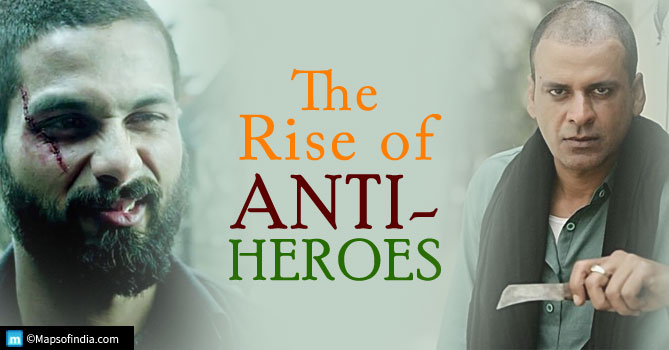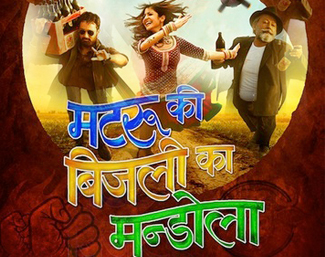He jumps fearlessly into the moving vehicle, ready to save the girl. His fist lands square on one of the thug’s face, he kicks the other one out of the car. By the end, he has saved the girl, the day, and killed the bad guys. He is our Bollywood hero, or at least the picture of him that has occupied our minds for the greater share of Indian cinema. But as our cinema grew ahead in time, it also did so in vision. No longer are all the characters at the extreme ends of the colour spectrum. With Bollywood inviting in new heights, it has also invited in “the grey”, the anti-villains of our movie industry.
Through the ages:
Kismet (1943)
Starring Ashok Kumar, this movie put a stop to “heroic” characters, being the first anti-hero movie of Bollywood. It revolved around the story of a young thief, played by the iconic Ashok Kumar. The movie was also the first to show a mainstream “hero” playing the role of a villain. Despite shocked reactions from his fans, the movie was a big blockbuster hit. It was the first Bollywood movie to have hit the “crore club”, with earnings up to one crore. Kismet was also on screens for over three years, creating a record in its own time.
Mother India (1957)
Although an obvious name to the list, Mother India has always been seen as the iconic anti-hero movie of its time, even beyond. The movie starred Sunil Dutt, an actor who has won hearts with movies like Padosan. Here, he played the role of a village bandit, and the movie won hearts and praise all around. Dutt later went on to play negative characters in movies like 36 Ghante (1974), Mujhe jeene do (1963).
Gunga Jumna (1961)
The Dilip Kumar starrer film started the trend of ‘two brothers fighting on the opposite ends of crime’. In the movie, Gunga (played by Dilip Kumar) transforms into a village bandit, having been subjected to hardships and injustice. His brother, Jumna, joins the ploce force, leading to an inevitable face-off between the two. The movie popularized the theme, with movies like Deewar, Amar Akbar Anthony etc following.
Sholay (1975)
The 70s were an iconic time for our cinema. The Jai-Veeru duo warmed our hearts, and Gabbar Singh (Amjad Khan) made it clench in fear. The country will remember “Kitney aadmi they?” for as long as there is cinema to remember. Gabbar Singh gave our cinema viewers a villain that was more than just a side character to add to the charisma of the hero.
Don (1978)
Having an actor like Amitabh Bachchan playing a negative character brought this movie its fare share of limelight. The movie went on to become such a huge success that till date, Bollywood has seen remakes of the movie hitting the big screen. The remake stars Shah Rukh Khan as the lead character.
Mr. India (1987)
Despite being titled after the hero of the movie, we all hear “Mogambo khush hua.” in our heads as soon as somebody mentions Mr. India. The movie was iconic, both for giving India its own ‘superhero’, as well as a supervillain. Starring Amrish Puri in the role of Mogabmbo, the ultimate villain, the movie won hearts and continues to do so.
Satya (1998)
Considered by the critics to be one of Ram Gopal Verma’s finest movies, the movie has created a niche for itself in Bollywood. The movie is about organized crimes in India, and was written by Saurabh Shukla and Anurag Kashyap. The film was a major career pushers for Kashyap and Manoj Bajpayee (who played Bhiku Mhatre in the movie). The movie has been called one of the most influential movies of its decade, and has been an inspiration for sequels in 2000s.
Omkara (2006)
Adopted from Shakespeare’s Othello, the movie is considered to be among Bollywood’s finest specimens. The movie deipcts its political underplay brilliantly, with ‘Langda’ Tyagi capable of boiling our blood till date. The role was played (and commendably at that) by Sai Ali Khan- an actor with coutnless “white” shade characters to his name. Vishal Bhardwaj created a spectacular movie, smoothly bringing in parallel and mainstream cinema together.
Kaminey (2009)
Starring Shahid Kapoor, the movie is a saga of rivalry between twins. It fared well on the box office, while earning approval from the critics. Shahid, an actor who is usually seen playing positive characters, brought the darker shades on screen nicely. The movie was praised for its realistic characters, not bordering on godliness or devilry- catching a grasp of the ‘in between’.
Gangs of Wasseypur (2012)
Often seen in the same light as Omkara, the movie is considered to be a modern day cult film. Despite not having a collection big enough as the mainstream movies, Gangs of Wasseypur has endless praises and fan following to its name. Sardar Khan, the villain that you just cannot hate, is played by Manoj Bajpayee, with a streak of famous dialogues behind.
Haider (2014)
Another movie based on Shakespeare’s play, Haider takes life from Hamlet. The movie is also an adaptation of Curfewed Night, a memoir of the 1995 Kashmir conflicts by Basharat Peer. It traces the life of Haider (Shahid Kapoor), a man set out in the search for his father, only to lose his sanity to it. The movie deals with the darker sides of human lives and of our capabilities.
With new movies like Padmavat arriving at the big screen with huge success, showing characters like Khilji (Ranveer Singh), we see a shift in audience’s perception. The anti-heroes have emerged as characters liked as much as the “heroes”, if not more. Started by Kismet in 1943, carried forward to this day with movies like Padmavat, the era of anti-heroes is on a rise.






